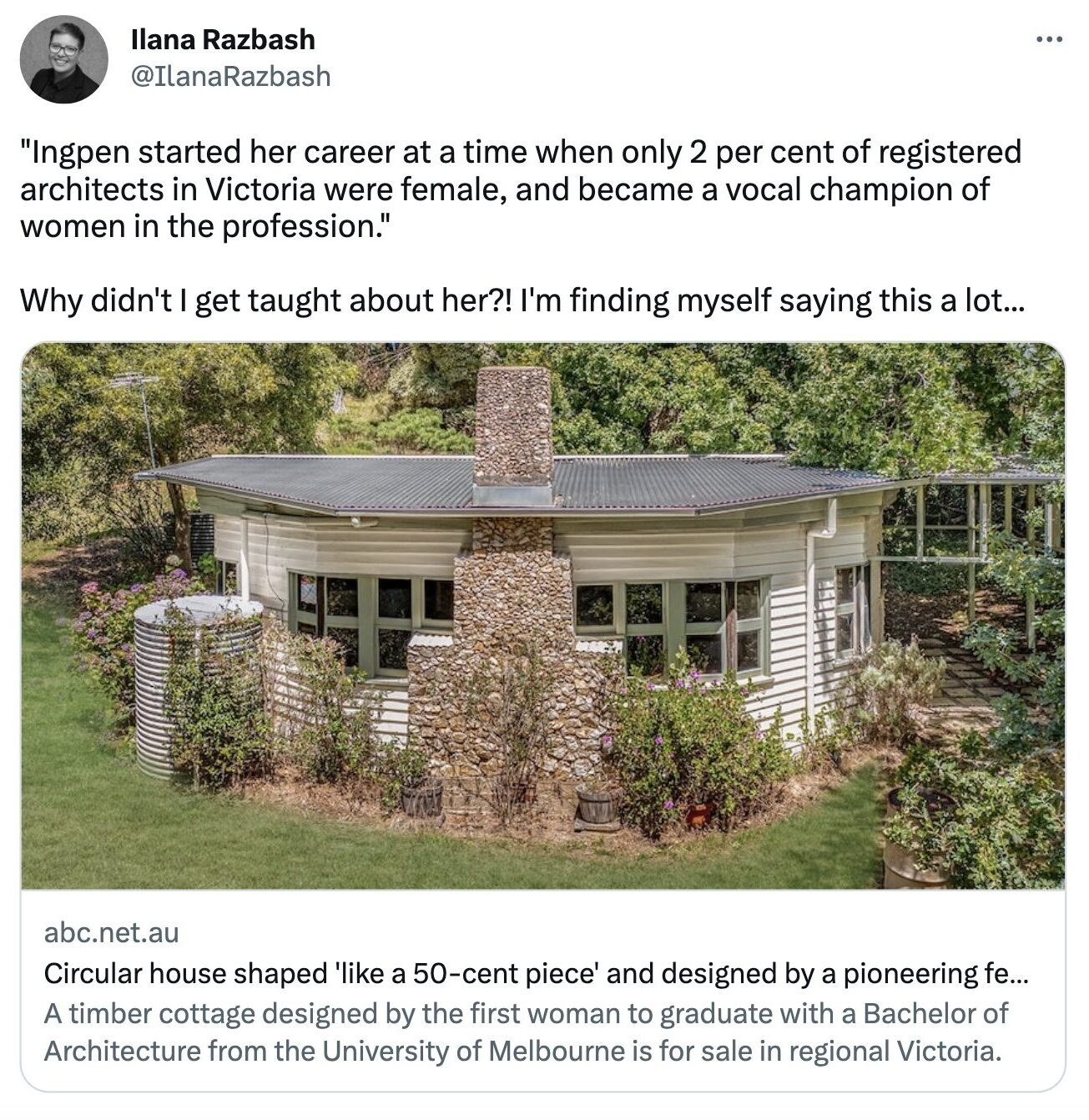We can’t control why or by whom our stories will be retold but we can leave as much material behind as possible. Ilana Razbash urges us all to claim adequate space and visibility online so our future histories will reflect our diversity.
Another obscure yet captivating property put on the private market has recently made mainstream media headlines. This one happens to be one of the few known and remaining works by “pioneering female architect [of] the 1930s” Edith Ingpen. I take a long pause. Why is it that I didn’t know about her? Why didn’t WE know about her? Researching more into Ingpen I was shocked to discover that she had an arguably very successful career and even a street in the ACT named after her! We can thank Professor Julie Willis and Emeritus Professor Harriet Edquist for unearthing much of the material on her body of work.

I remember studying many lesser known and less-prolific architects. Many were inter-war and post-WWII immigrants who came to Australia and made their marks on our cities, suburbs and history books. Unfortunately very few of them were women. Edith Ingpen is not the first and unfortunately won’t be the last to go underwritten in history. The reasons why this happens are plenty and I won’t lament them here.
Instead I would like to focus on the immense opportunity that we have in our present cultural moment. I see so much hope in the emerging diversity of our recent professional culture in Melbourne. Queer, trans, gender-diverse, Indigenous, immigrant, rural, parent/carer, student, young and mature-age voices are all being heard, and gaining platforms alongside women of all backgrounds and walks of life. Representation is real and your presence in the profession and cultural community is not obscure nor a novelty.
Please don’t get me wrong – this is in no way about great fame and publicity. It’s about not being left out when your voice matters. It’s about making your presence known in contrast to unearned fame and prestige. It’s about ensuring that your brilliant talents, innovative thinking and offerings to our public life do not disappear when you retire. We need your hope, your ideas and your passion. There is no time more important than now to bring civic imagination to your work and life.
We can’t control why or by whom our stories will be retold but we can leave as much material behind as possible. Not simply as archival stock and unreadable troves of data, but rather your presence in the public and professional consciousness. It’s imperative that architects and members of our expanded professional practice sphere take control of the narrative now. You must show up for the world you want to see. Show up for what you want the architectural profession to be. Champion the value of good design, advocate for your professional services, fight for the preservation of public space and historic buildings, demand better ventilation and clean air – whatever your cause may be, just remember to make it known.
The first person who comes to mind as somebody who defied the odds of their time to make it into the popular canon is Alison Smithson (1928–1993) – architect as well as educator and prolific writer. Her fierce editorial and publication efforts cemented the Smithsons’ reputation, not for their humble early-career portfolio of built works but rather largely for their well-documented writing, architectural thinking and pedagogy.
The growth of Web 2.0 platforms have democratised the possibilities for this content creation beyond the tightly guarded printing presses of institutions and academies. Anyone can start a blog, a newsletter, a podcast, a social media profile… The possibilities for dissemination of architectural ideas are truly endless. The beauty and terror of these technologies is that every word, every image, every ‘Like’, leaves behind a trail of data – SEOs, keywords, Google Search terms and hashtags. Use them to your advantage. Over time, these little artefacts add up to create a picture of who you are as a professional.
Of course, not everyone has the time and resources for prolific publications, content creation, additional unpaid labour and endless marketing. These extracurricular activities are indeed a privilege but there are small non-burdensome actions that you can take today:
- Add your profile to Marion’s List and invite five other colleagues to do the same.
- Get your annual CPD points with providers who will also give you good networking opportunities.
- Attend a talk and be brave enough to put your hand up and ask a question. Say your name.
- Start an Instagram account for your professional persona and post at least once a month.
- Sign up to host Parlour’s Instagram for a week.
- Start a professional Twitter or Mastedon account and get onto #ArchitectureTwitter. This is a great way to also break out of the echo chamber and talk to “real people” more.
- Nominate yourself and other women or people from diverse minorities for awards when they come up.
- Join and support organisations such as the Parlour Collective that are doing the hard work of writing women and marginalised communities into history.
Ever focused on the future tense, we neglect the present moment. The next goal, the next project, that next milestone and deadline – in amongst the hustle of rushing towards a future newness, we ultimately forget that tomorrow’s story is written today.
Ilana Razbash is a registered architect in Victoria with a passion for creating buildings that benefit people and communities. She has worked on a variety of public, education, sporting and community projects throughout her career. With a current focus on the health sector, she is dedicated to designing buildings that contribute positively to the wellbeing of people and place. Ilana is interested in innovative procurement, plurality within architecture and radical listening. She continues to share her thoughts and passions on architecture through numerous industry speaking panels and writing contributions.




















